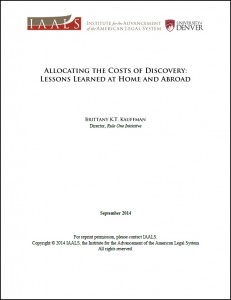New Report on Cost Allocation in Discovery Explores Lessons to be Learned at Home and Abroad
 Under our Rule One Initiative, we have focused much of our time and effort over the last seven years on ways to improve the effectiveness of discovery. In large part, this is due to the expanding world of information—including electronically stored information—and the corresponding expansion in potential discovery. And with the growth of discovery comes the challenge that litigants, attorneys, courts, and rulemakers face in keeping that discovery reasonable and proportional.
Under our Rule One Initiative, we have focused much of our time and effort over the last seven years on ways to improve the effectiveness of discovery. In large part, this is due to the expanding world of information—including electronically stored information—and the corresponding expansion in potential discovery. And with the growth of discovery comes the challenge that litigants, attorneys, courts, and rulemakers face in keeping that discovery reasonable and proportional.
Along with time (and the corresponding delay), it is the cost of discovery that underscores the need for proportionality. Thus, understanding how the courts and the rulemakers have addressed the costs of discovery, including their allocation between the parties, provides important background and context for future recommendations.
In our new report, Allocating the Costs of Discovery: Lessons Learned at Home and Abroad, we review the laws in the United States and other countries and provide examples of, and analogies to, various cost allocation models. We look to the various approaches for commonalities and lessons that can be learned, both at home and abroad. One of the key takeaways is the importance of proportionality. Proportionality has become the axis around which the efforts to limit the expanding costs of civil litigation have rotated, both in the United States and abroad.
The report can be downloaded here.


